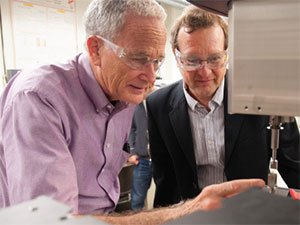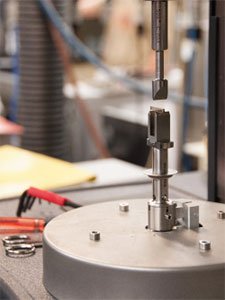First MN-IP license leads to promising advances in composites

Frank Thibodeau of Artiman Ventures, a Palo Alto venture capital firm, is on a mission. For the past four years, Thibodeau has been tenaciously pursuing ways to improve the quality of a certain class of composite materials, the reinforced plastics used to make a broad variety of high performance products in the aerospace, automotive, marine and sports equipment industries. Think spaceships, race cars, boat hulls and tennis rackets.
Thibodeau, who is well versed in the science and economics of composite materials, wanted explore new techniques for making stronger, more versatile composites that are less costly to produce than the current models. Armed with some promising initial data from research at the University of Hawaii, Thibodeau sought out the right expertise to test these theories. He found that talent in an interdisciplinary research team in the University of Minnesota’s College of Science and Engineering.
"We had some intriguing findings, but we didn't have the right expertise to really put them to the test," said Thibodeau. "I was looking for a group with the right set of skills in materials chemistry and polymer engineering to take these data to the next level.”
Through Adama Materials, a startup company launched to commercialize the technology, Thibodeau funded a two-year research project at the U of M led by Dr. Chris Macosko, a chemical engineering professor and polymer expert, and Dr. Andreas Stein, a chemistry professor with expertise in nanocomposites and materials chemistry.
Just one word. Plastics.

Fiber-reinforced composites, the kind used in high-performance plastics, generally consist of a fabric or substrate (glass, carbon or other fibers) combined with a polymer matrix (glue, epoxy or resin of some kind). The problem is that the polymers used can be brittle and unable to adequately absorb impact. This can lead to cracking. Existing technologies for making polymers tougher have drawbacks though: as the polymer increases in durability, it becomes more flexible, bendable, and decreases in strength.
Recent advances in composite materials have explored the use of modified nanoparticles, such as graphene, to make the polymers stronger without losing other properties. (Graphene was the subject of the 2010 Nobel Prize for Physics and is now being touted as a “miracle material.”) Up until now, the quantities of graphene needed to strengthen the polymer have been relatively high. While the properties are there, the cost is increased significantly as more graphene (or filler) is used, making the option less appealing. In their research, Macsosko and Stein are perfecting a method that requires a much smaller percentage of filler than previously thought.
“By modifying the surface with different functional groups, we identified a way to make the nanosheet compatible with the polymer so it mixes well,” said Stein. “This method requires less graphene, making it more attractive for commercial use.”
The new technology, which has a patent pending through the University of Minnesota, was recently licensed by Adama Materials through the U of M’s Office for Technology Commercialization. As Adama Materials takes this technology into the growing composites market, the discovery has the potential to have a major impact on the high performance plastics industry.
MN-IP a model of success
In addition to the exciting technological advances that resulted, there’s another reason to celebrate this successful collaboration. It’s the first MN-IP sponsored research agreement to have a license deal finalized.
MN-IP, or Minnesota Innovation Partnerships, is a U of M program launched in December 2011 to provide more security and flexibility to companies interested in sponsoring research at the U. As a venture capitalist, Thibodeau was attracted to the MN-IP model, which allowed him to secure an option to an exclusive license for the technology up front, eliminating the need for lengthy, and sometimes costly, negotiations once the research is complete.
“It was clear to me that the U of M has looked a lot harder at what industry needs and how industry wants to work with universities,” said Thibodeau. “I tell other industry people – and other universities – about the MN-IP program all the time.”
Sponsored research, like the kind conducted by Macosko and Stein, provides critical resources for conducting research that has the potential to address important societal needs, such as developing medicines for life-threatening illnesses or developing new food processing techniques to ensure the food we eat is safe. On the flip side, it fulfills an industry need for specialized research that does not require substantial investments in infrastructure, equipment and staff.
Perhaps a less acknowledged benefit is that it gives graduate students, who play a large role in most research projects, the opportunity to get direct experience working with industry. And since many graduate students ultimately end up seeking jobs outside of the university, this experience is invaluable as necessary training for the students. In the end, it also ensures a well-trained workforce.
Reprinted with permission from Business @ U of M, a publication of the Office of the Vice President for Research.
Photos by Andria Waclawski
